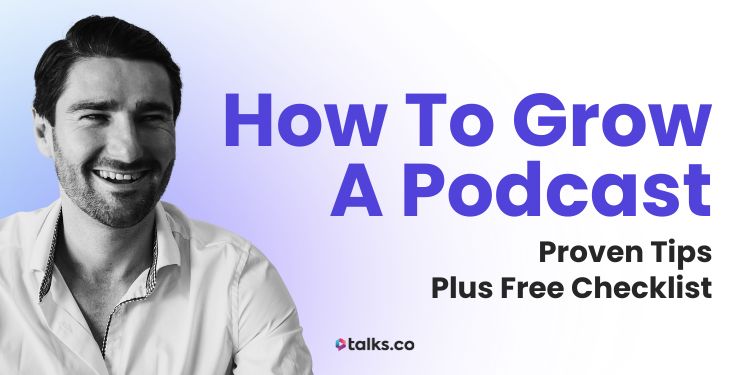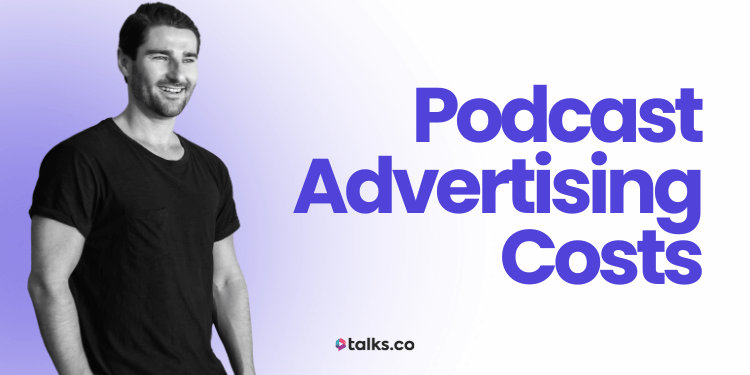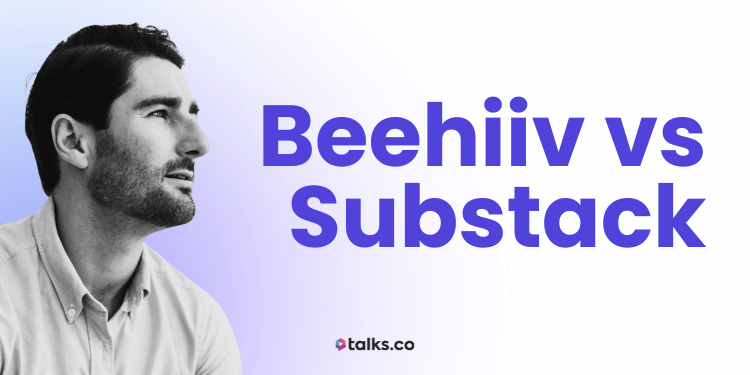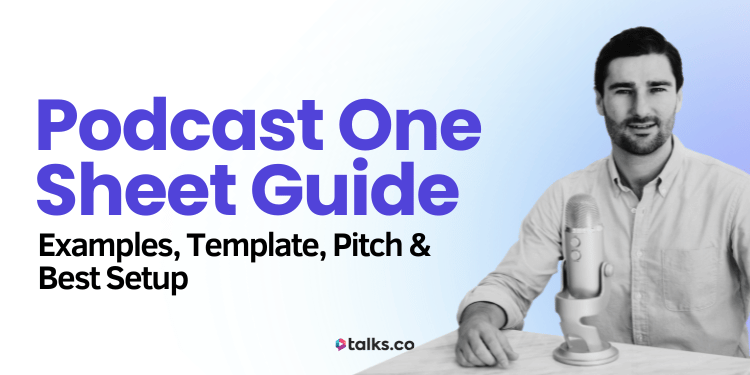Have you ever wondered how some podcasts seem to grow out of nowhere while yours is still sitting quietly on the sidelines?
If you’ve got the mic, the message, and the motivation… but no audience (yet), you’re in the right place.
When I started back in 2015, I was recording interviews on Zoom with a Blue Yeti mic and a $99 webcam. Nothing fancy. No team. No viral clips. Just real conversations and a real commitment to showing up.
Fast forward to today, I’ve done over 400 interviews, spoken on 60+ podcasts, and built a business that lets me work from anywhere. Sometimes that means recording from my kitchen in Malta, other times from a cafe somewhere in Australia.
But here’s the part that matters most. It didn’t happen overnight, and it didn’t require fame, followers, or flashy gear. What it took was knowing what works, staying consistent, and thinking one step ahead.
This guide is here to show you how to grow a podcast even if you’re starting with zero audience. I’ll walk you through the exact strategies I’ve used (and seen work again and again for others).
From getting your first few listeners to turning your show into a visibility machine that grows your brand, your reach, and your income.
You’ve already got something valuable to say. Let’s make sure more people hear it.
How to Grow a Podcast
To create a podcast is one thing. Growing it? That’s where most people get stuck.
The truth is, good podcast content alone isn’t enough. There are thousands of great shows out there that never get heard. Not because they’re not valuable, but because they’re not visible.
What you’re about to read are real strategies I’ve used (and seen work) to grow a new podcast from zero. No fame, no budget, no team.
Let’s walk through the steps together.
How to grow a podcast fast
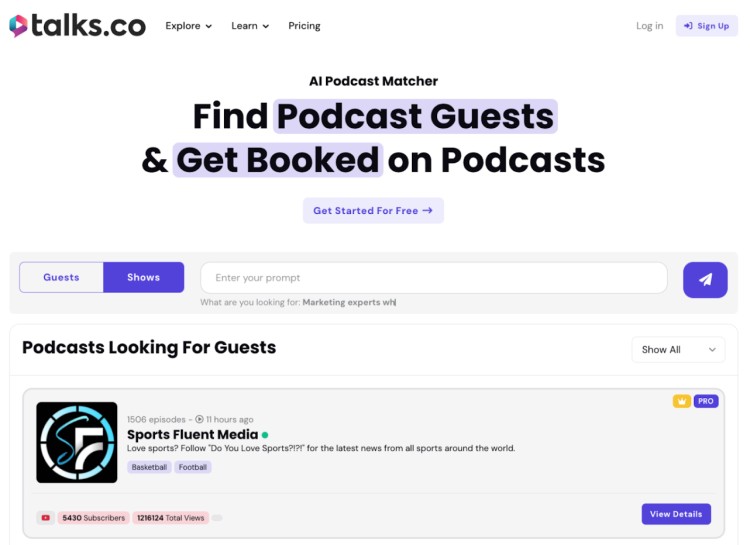
There’s no magic trick to help grow a successful podcast, but there are shortcuts that actually work.
Here’s what I’d focus on if I were starting a podcast from scratch today and wanted to grow my podcast listenership fast:
- Guest on other podcasts to get visible fast. This is hands-down the fastest way to grow. Tap into target audiences who already listen to podcasts and share your expertise. After every interview, ask the host, “Who else do you know that runs a podcast I’d be a good fit for?”
- Pre-record solo ‘evergreen’ content. Perfect for those weeks when you’re not recording interviews. It protects momentum. You also have full control over how long your podcast should be.
- Repurpose your podcast content into social media posts. Clip your best 30 to 60 seconds and use them to promote your podcast on social media. Use captions for your podcast episode. Use square or vertical video. And make sure your video quality is solid. Use good lighting, a clean mic, and something better than a laptop webcam.
- Give people a reason to listen to your podcast now. Use clear, benefit-driven podcast titles for your podcast episode. Think: “How to Land High-Ticket Clients from a Podcast Interview” not “Episode 42: Interview with Jane.”
- Ask for shares and reviews directly. Don’t assume people will do it on their own. If they got value from your podcast episode, they’ll often help grow your podcast when asked.
You don’t need to be famous to get more podcast listeners. You just need to be clear, consistent, and visible when building a podcast.
How to grow a podcast audience
Getting listeners is one thing. Keeping them and turning them into fans is another.
Here’s what helps:
- Know exactly who you’re speaking to. The more specific, the better. You’re not trying to be for everyone. If your podcast niche is for fitness coaches over 40 or spiritual entrepreneurs building group programs, say it up front. This will make it easier for you to find podcast guests, too.
- Open strong, close stronger. Your first 30 seconds should hook the listener. Your last 30 seconds should give them a reason to come back or share the episode.
- Build an email list alongside your podcast. Even a simple freebie related to your podcast show topic (like a checklist, cheat sheet, or PDF guide) can help you turn casual listeners into subscribers and expand your audience.
- Mention listener names. Use listener names in your intros or answer voice messages on air. It builds loyalty fast.
- Add voice notes in your episodes. Turn fan DMs into audio shoutouts or let them send in voice messages via SpeakPipe to grow your show. Makes the show interactive and sticky.
- Use listener Q&A episodes as a growth engine. Source real questions from your audience and answer them live. Helps with retention, podcast SEO, and builds community around your podcast.
Growing an audience isn’t about being everywhere. It’s about being relevant and easy to connect with.
How to start and grow a podcast

If you’re just getting started and want to grow from day one, here’s what I recommend:
- Keep your gear simple but solid. A quality mic (I still use my Blue Yeti or a lapel mic when I travel), decent lighting, and a reliable webcam or camera can go a long way.
- Record your first few episodes in advance. Start with a small buffer of episodes so you’re not racing the clock from day one.
- Use the first ten episodes to build trust and credibility. Interview experts your audience already respects or create solo episodes that deliver real value. This builds authority early.
- Promote each episode with purpose. Don’t just post “New episode is live!” Instead, pull out a key quote, share a short video snippet, or ask a related question to start a conversation.
Starting and growing a podcast with no audience (yet) doesn’t have to be complicated. You just need the right foundation, a clear plan, and a willingness to keep showing up.
How Long Does It Take to Grow a Podcast?
It depends on your topic, your consistency, and how well you promote it. But here’s the honest answer most won’t tell you:
You can start seeing real traction within 90 days if you:
- Publish weekly
- Promote each episode properly
- Get in front of new audiences through guest interviews or collaborations
But here’s the part that matters more: podcast growth compounds. If you stay consistent for 6 to 12 months, you’ll be miles ahead of everyone who stopped at episode 7.
It’s not about going viral. It’s about becoming a regular part of someone’s week.
When and how to monetize (without ads)
You don’t need a massive audience to start earning from your podcast and you definitely don’t need to wait for sponsorship deals to roll in. Some of the best strategies to grow and monetize your podcast start with a small, loyal audience.
Here’s how to start monetizing your podcast without ads:
- Promote your own offers: If you sell coaching, courses, digital products, or even a membership, your podcast becomes a powerful trust-building tool that naturally leads to sales. Mention your offer casually during the episode or in the outro. No hard pitch needed.
- Create a premium tier: Platforms like Supercast or Patreon let you offer bonus episodes, early access, or ad-free content for a monthly fee. Even if only 5-10% of your listeners subscribe, that adds up quickly.
- Use affiliate partnerships: Recommend tools, books, or programs you genuinely use and love. Then use trackable links to earn a commission when people buy. (Tip: Mention these links out loud and include them in your show notes.)
- Host live workshops or challenges: Use your podcast to fill a free challenge or low-ticket workshop. It creates urgency, gives value, and often leads into a higher-ticket offer on the backend.
You don’t need 10,000 listeners to make money from your podcast. You just need the right offer for the right audience and a clear next step.
How to measure podcast growth (and what metrics matter)
Downloads alone don’t tell the full story of the quality of your podcast. Instead of obsessing over vanity metrics, track the numbers that actually help you grow your podcast and move your business forward.
Here’s what to measure:
- Episode retention rate: Are people staying through the end of your episodes? Most podcast hosts (like Apple Podcasts and Spotify for Creators) show drop-off points. Use that data to improve your structure, intros, and delivery.
- Top-performing topics: Which themes, guests, or titles drive the most listens or shares? That’s your roadmap for what to do more of.
- Traffic and opt-ins from your podcast: Use trackable links or dedicated landing pages in your show notes. This helps you see if your podcast is actually building your email list or sending traffic to your podcast offer.
- Growth of your podcast over time: Look at 30-day or 90-day trends instead of obsessing over daily fluctuations. Are your average downloads per episode going up?
- Listener feedback: Reviews, messages, shares, and replies tell you a lot. If someone says “I took action on this,” or “This changed the way I think about X,” you’re creating real impact.
Your podcast isn’t just content, it’s an engine. And engines need dashboards. Start measuring what matters so you can launch your podcast and learn how to grow smarter.
What to do when growth hits a standstill
Even the best shows plateau sometimes. If you feel like your numbers have stalled, don’t panic. Get curious.
Here’s how to troubleshoot and kickstart growth again:
- Revisit your positioning: Refine your niche by identifying the number one pain point your audience wants solved. You might be one tweak away from traction.
- Refresh your format: Add solo episodes, short-form content, or new segments. You might be one format tweak away from better engagement.
- Change your podcast marketing strategy: Are you just posting “New episode is live” graphics? Try audiograms, reels, teaser clips, or quote cards that highlight a key takeaway. Make the episode feel useful before they even click.
- Tap into other audiences: Get on other podcasts. Partner with other podcast creators who have engaged followings. Collaborate on cross-promotions or get booked on bonus episodes with related shows for more audience growth.
- Ask your listeners: Literally. Use a poll, Instagram story, or your email list to ask, “What do you want more of?” You’ll be surprised how much people are willing to share when you ask.
Plateaus don’t mean failure. They just mean it’s time to experiment. Small changes can unlock big momentum.
How to Grow a Podcast Following
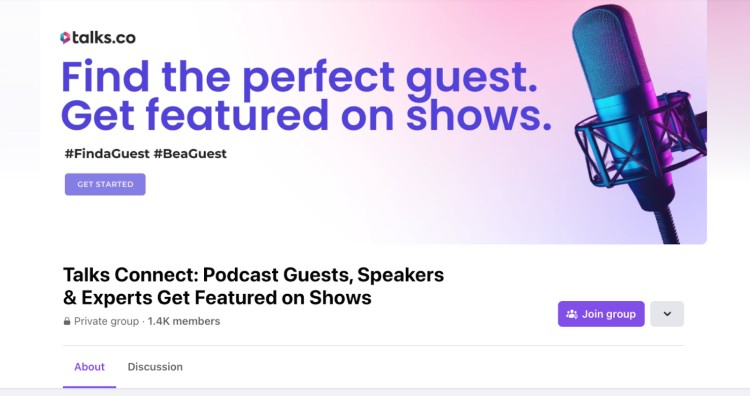
If you want people to keep coming back (and telling others about your show), make sure you’re focused on building a relationship, not just a listener count.
Here’s how to help your podcast launch:
- Give them a reason to follow you off the podcast. Link to your email list, freebie, or Instagram. Get them into a space where you can interact more often and keep your audience engaged.
- Create episodes people want to share. These types of podcasts usually mean strong opinions, highly actionable tips, or emotional moments that hit home.
- Stay consistent. A regular schedule builds trust. Your audience should know when to expect your next episode.
- Run a private podcast feed for subscribers only. Instead of a PDF, give bonus audio via a private RSS feed. Feels more aligned with podcasting and adds perceived value.
Building a loyal following is a long-term play… but it’s the key to lasting growth.
Want more support? Join the Talks Connect Facebook group where podcasters pitch, find guests, promote shows, network, and learn from each other. It’s a great way to connect and grow their audience faster.
How to grow a podcast on YouTube
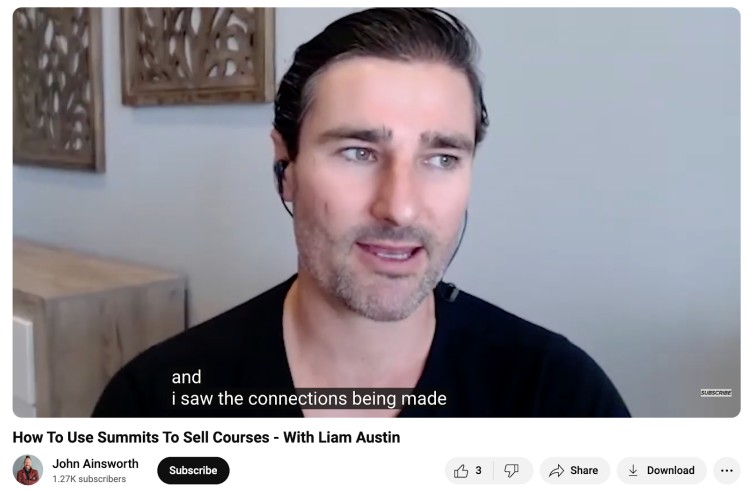
YouTube can massively expand your podcast’s reach, but it works differently than Apple Podcasts or Spotify.
Here’s what to do:
- Use video when possible. People come to YouTube to watch, not just listen. You don’t need a full studio, just solid lighting, a decent mic, and a camera that shoots in 1080p or 4K (a DSLR or a good webcam can do the trick).
- Edit like a YouTube creator. Review your podcast and cut out fillers. Add titles, graphics, or use a podcast B-roll when it makes sense. Keep your intro short.
- Title your episodes like YouTube videos. Think: “How I Got 10,000 Podcast Downloads in 30 Days” not “Episode 5: Growth Tips.”
- Use chapters and timestamps. These help with retention and searchability.
- Optimize for SEO. Use relevant keywords in your title, description, and tags so your video shows up in search engines and social media platforms.
You don’t need a million subscribers to win on YouTube but you do need to respect the platform.
How to grow your podcast on Spotify
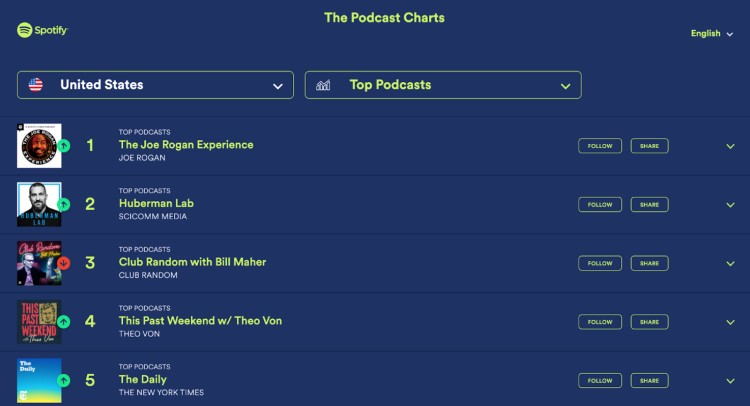
Spotify has become one of the biggest podcast platforms and it’s designed for growth if you use it right.
Here are strategies for growing your podcast:
- Write a strong episode title and description. Spotify doesn’t have ratings or reviews, so the title and cover art carry more weight when trying to grow your podcast.
- A/B test episode titles over time. Some platforms let you quietly update titles after publishing. Use data to guide headline tweaks.
- Submit your podcast to Spotify early. The sooner you’re there, the sooner you can get picked up by their algorithm.
- Create and promote Spotify links specifically. If your audience listens there, make it easy. Use Spotify’s sharing tools for stories, posts, and reels.
- Encourage listens from the first 24-48 hours. This helps boost the visibility of your podcast in their system.
Spotify rewards consistency and engagement, so make each episode count.
How to post a podcast on LinkedIn
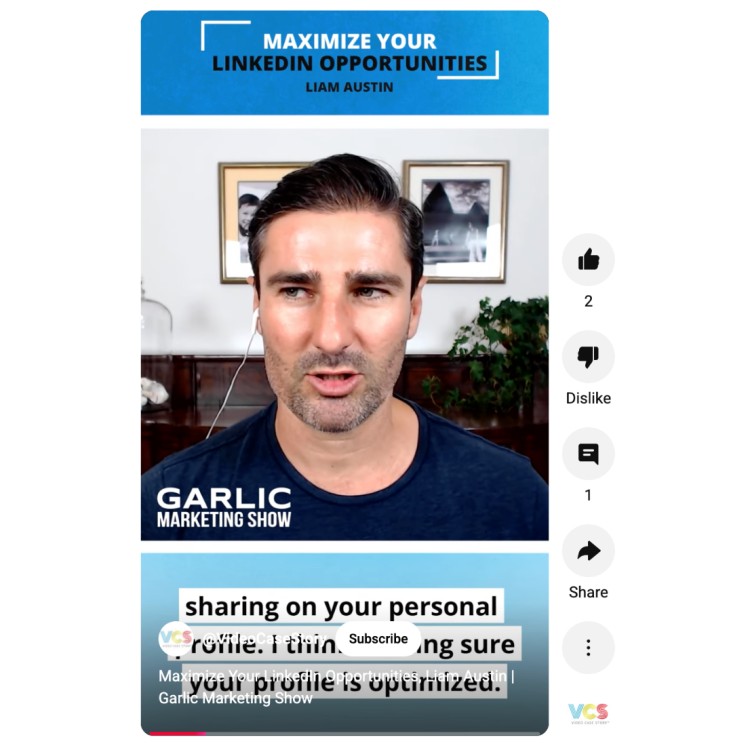
Does your audience include professionals, consultants, or B2B clients? LinkedIn is your goldmine.
Here’s how to share your podcast in a way that actually gets attention:
- Don’t just post the link. Add context. Share a personal insight, a quote from the episode, or a quick story that connects with your audience.
- Use video snippets. A 30-second clip with captions can stop the scroll and boost watch time.
- Tag your guests (if they’re on LinkedIn). This helps expand your reach and shows you’re connected to credible experts.
- Use a native upload strategy. Instead of just pasting a Spotify or Apple link, upload a short teaser video directly to LinkedIn and include the full link in the comments.
- Ask a question or invite discussion. Engagement boosts visibility. For example, “What’s the biggest lesson you’ve learned from being on a podcast?”
LinkedIn rewards content that feels human and useful. Lean into that.
How to Grow Your Podcast Listeners
If you want more people listening, it starts with making your podcast easier to find, easier to enjoy, and easier to share.
Here are some proven ways to grow your listener base:
- Use a lead magnet to turn listeners into email subscribers. Once they’re on your list, you can bring them back for future episodes and eventually into your programs or offers.
- Focus on discoverability. Your episode titles, descriptions, and cover art should all be working to attract your ideal audience. Think benefits first, not clever names.
- Pitch a podcast roundup list on Medium or LinkedIn. Include your own show. It builds visibility and SEO at once.
- Make your content shareable. Great soundbites, video clips, and quotes give your listeners something they’ll want to post.
- Track what’s resonating. Which episodes get the most plays or shares? Which ones get replies or DMs? Do more of what works.
Remember, you don’t need hundreds of thousands of listeners. You just need the right people listening and taking action.
How to land podcast collaborations or swaps
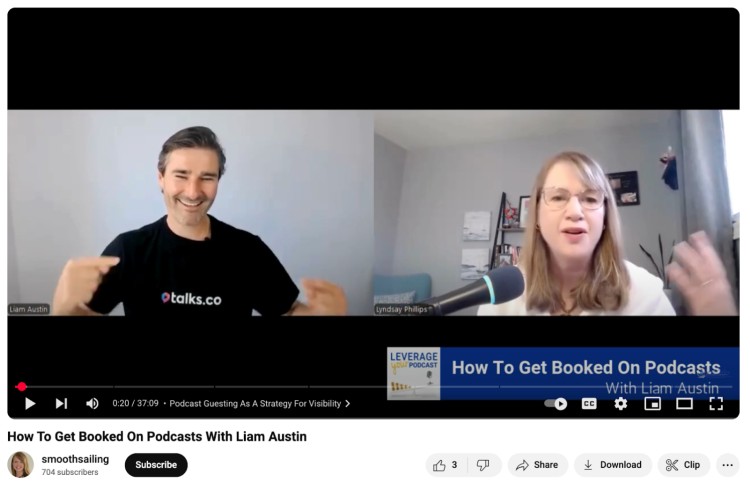
Collaborating with other podcasters is one of the fastest ways to grow your audience and build authority. Podcast swaps or guest exchanges give you exposure to new listeners who already trust the host and that trust transfers to you.
Here’s how to be a guest on podcasts that lands collaborations or swaps:
- Identify the right partners: Look for podcasts with similar audience sizes and overlapping topics but not direct competitors. Use podcast directories like Apple Podcasts, Spotify, or tools like Talks.co to find shows your ideal listeners already follow.
- Listen and research: Before reaching out, listen to a few episodes. Understand their style, tone, and what topics they cover. This helps you prepare for your podcast interview, tailor your pitch, and show genuine interest.
- Craft a clear, personalized pitch: Keep it brief and focused. Introduce yourself, mention what you like about their show, and propose a swap or collaboration idea. Highlight how your audience aligns and what value you can bring to their listeners.
- Offer value upfront: Suggest a topic or episode idea that fits their audience. You might also offer to promote their episode heavily on your channels. Mutual benefit is key.
- Be flexible with timing: Podcast schedules can be tight. Show you’re willing to work around their availability and deadlines.
- Follow up politely: If you don’t hear back in 7-10 days, send one gentle follow-up. Keep it friendly and non-pushy.
- Prepare your episode thoroughly: When the swap is confirmed, record a quality episode tailored to their audience. Deliver your best content to build trust and open doors for future collabs.
- Promote cross-ways: After publishing, share the episode on your platforms and encourage the host to do the same. Tag each other on social media to boost visibility.
Podcast collaborations aren’t just growth hacks. They’re community builders. Approach them with generosity and professionalism, and you’ll unlock new audiences faster than going it alone.
5 Ways to Grow Your Podcast Audience
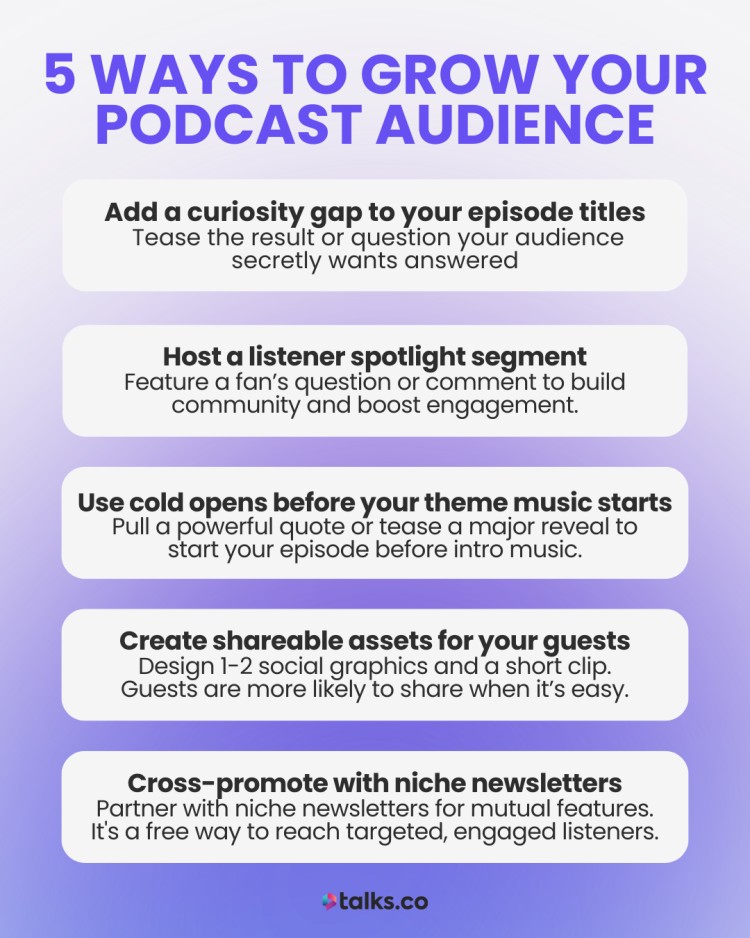
If you want a bigger audience, you need more than just good content. You need the right systems and strategies behind the scenes. That’s what makes a good podcast.
Here are five ways to grow your podcast audience:
- Add a curiosity gap to your episode titles. Instead of summarizing the topic, tease the result or question your audience secretly wants answered. Think “She 10x’d Her Coaching Business. Here’s What Changed” instead of “How to Grow Your Coaching Business.”
- Host a listener spotlight segment. Feature a fan’s question, win, or comment at the start or end of your show. It creates community, builds loyalty, and encourages more listeners to engage (and share the episode they’re featured in).
- Use cold opens before your theme music starts. Pull a powerful quote or tease a major reveal to start your episode before intro music. Grabs attention faster.
- Create shareable assets for your guests. Design 1-2 Instagram or LinkedIn graphics and a short clip. The easier you make it for guests to promote the episode, the more they will.
- Cross-promote with niche newsletters. Find small but engaged email newsletters in your niche and offer to feature each other. A simple “guest spotlight” or shared resource can introduce your show to new, highly targeted listeners without spending a cent on ads.
5 More Quick Tips to Grow a Podcast Audience
Already doing the basics? Here are a few extra moves that can give your podcast more visibility and traction:
- Use SEO in your episode titles and descriptions. People are searching for answers. Make sure your show pops up when they do.
- Pin your top episode on your social platforms. Give new followers your best work up front.
- Use dynamic ad slots for cross-promotion. Many hosting platforms let you swap in new intros or mid-rolls. Use them to promote your own episodes or trade shoutouts with other podcasters. It’s like running a promo without editing your full episode.
- Make your intro count. Hook the listener in the first 15 seconds with what’s in it for them, not just who you are.
- Run a 30-day promo push. Pick one episode and promote it every day across different channels for 30 days. You’ll get more traction than just “dropping and forgetting.”
How to Plan a Podcast Growth Strategy
Podcast growth isn’t about luck. It’s about having a simple, repeatable plan.
Here’s how to build a strategy that works:
- Know your goal. What does growth look like for you? More downloads? More leads? More authority? Pick one main goal to guide your decisions. That’s podcasting 101.
- Choose your primary promotion channel. Instead of trying to be everywhere, focus on one platform where your audience already hangs out (email, Instagram, YouTube, LinkedIn).
- Set a content rhythm. Decide how often you’ll publish, promote, and repurpose. Example: One episode per week, two promos per platform, one guest appearance per month.
- Track what’s working. Look at downloads per episode, subscriber growth, episode drop-off points, and engagement on social posts. Use this data to double down on what works.
- Stay consistent for 90 days. Growth takes time. Commit to a 90-day sprint and treat it like a campaign. Then evaluate and adjust.
A growth strategy doesn’t have to be complicated. It just has to be consistent.
Be the Podcast People Can’t Stop Talking About
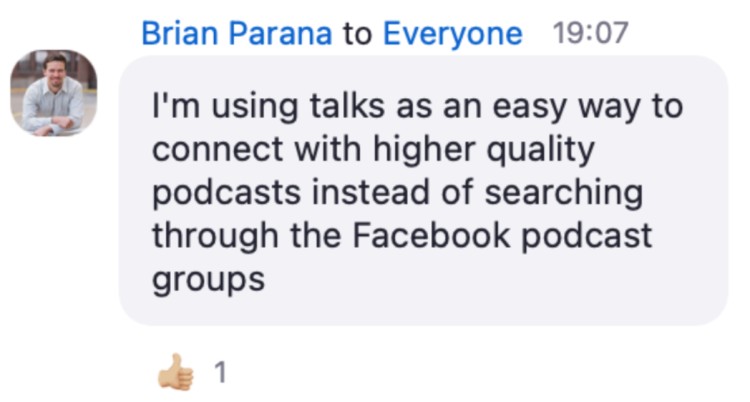
Most podcasters ask how to grow a podcast, but few take the steps that actually move the needle. The truth? Visibility comes from strategy, not just great content. And one of the fastest ways to grow is to get in front of the right people consistently.
That’s exactly what Talks helps you do.
Create your free Creator Profile and get discovered by podcast hosts actively looking for guests like you. You’ll also get matched with hosts in your niche so you can build your audience faster without hunting for guest spots yourself.
Yes, I Want More Podcast Listeners
